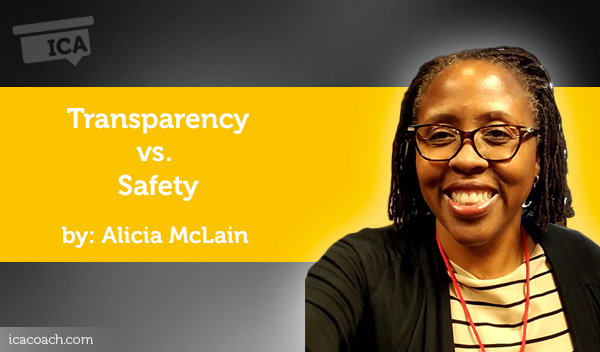
A Coaching Power Tool Created by Alicia McLain
(Executive Coach, UNITED STATES)
The power tool I selected is based on my experience in business but has application to the story I started here above.
In my world, we use the metaphor ‘in the closet’ to indicate someone is hiding their truth and doesn’t feel safe to be who they really are. I believe this is the case for more than those in my community. I would say that unless we’re prepared to ‘meet ourselves’ and embrace our truth, we all are in the closet to some degree.
My power tool is Transparency -> Safety
These two ideas are concepts I see in my daily work with clients.
Agile is all about building transparency in your operations. So much so, when Agile is introduced, it can be off-putting to those who like to work on their own and not be connected or accountable to others. One of the primary values of Scrum is, in fact, Transparency.
I’m not looking at these two so much as opposing ideas as I am looking at them as one (Transparency) building or fostering the other (Safety).
Transparency:
Oddly, the space where these ideals are introduced via Agile is in Software Development organizations. And transparency, in a computer science context, has meaning that is closer to undetectable or invisible. This brings up interesting things for me because it didn’t occur to me that because of their profession, the word could have meaning that is different than expected.
Google defines these two terms in this way:
With safety, I’d also explore this with teams/organizations. When I think of safety as it relates to teams and organizations, I think of psychological safety. Amy Edmondson, the foremost authority on this concept, defines it this way: Psychological Safety – a shared belief that the team is safe for interpersonal risk taking. In psychologically safe teams, team members feel accepted and respected (Amy Edmondson, Harvard Business School)
How do we get from one to the other? The table below explores some qualities and outcomes for each. I’m sure there can be many more, these are what come to mind for me.
Example: when I am fostering transparency I must act with integrity. When I feel safe, I trust that my story will be heard and handled with care.
 You could argue that the left doesn’t completely foster or build what’s on the right. You need what’s on the right under Transparency as well.
You could argue that the left doesn’t completely foster or build what’s on the right. You need what’s on the right under Transparency as well.
My take away from exploring this idea is that there are qualities in coaching/self that can help someone feel safe to ‘peek at’ or fully explore their truth in a way that can move them forward. And whether it’s my client Alana who is trying to figure out why she’ still mad at her ex-husband or an organization that is struggling through transformation, the reality is the truth will set you free and you have to feel safe explore it. For us to meet ourselves fully, we have to feel safe to come out of our own closet.